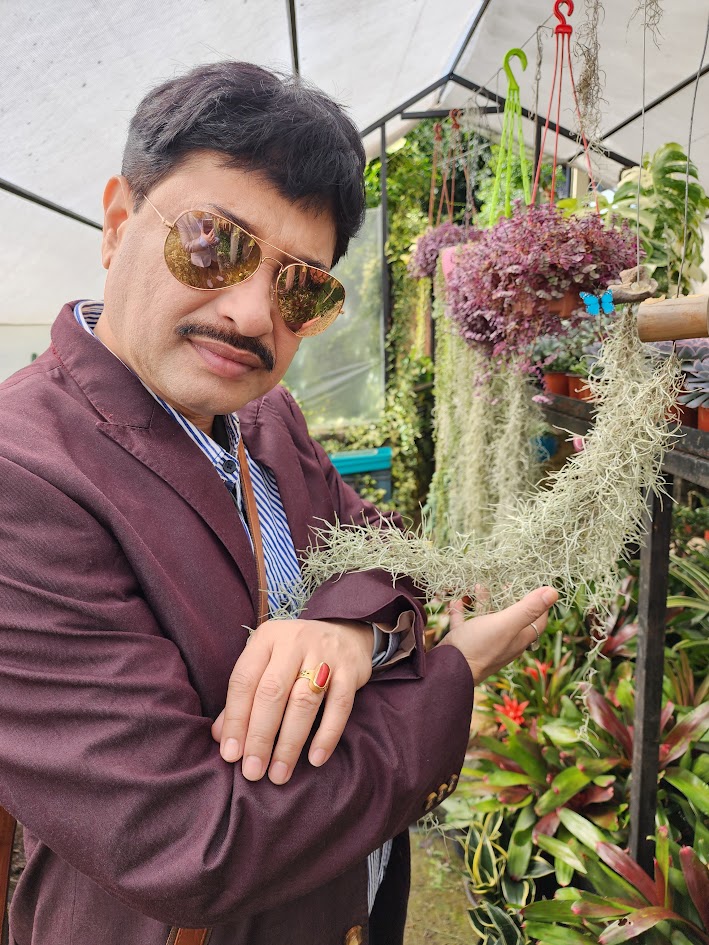Your front yard is the first thing people notice, and honestly, it tells a story about your home right away. Even small updates can seriously boost curb appeal and turn your yard into a place that feels like home.
You’ll find easy Front Yard Landscaping ideas here for a quick refresh, no matter your taste or the size of your space.
Let’s get started!
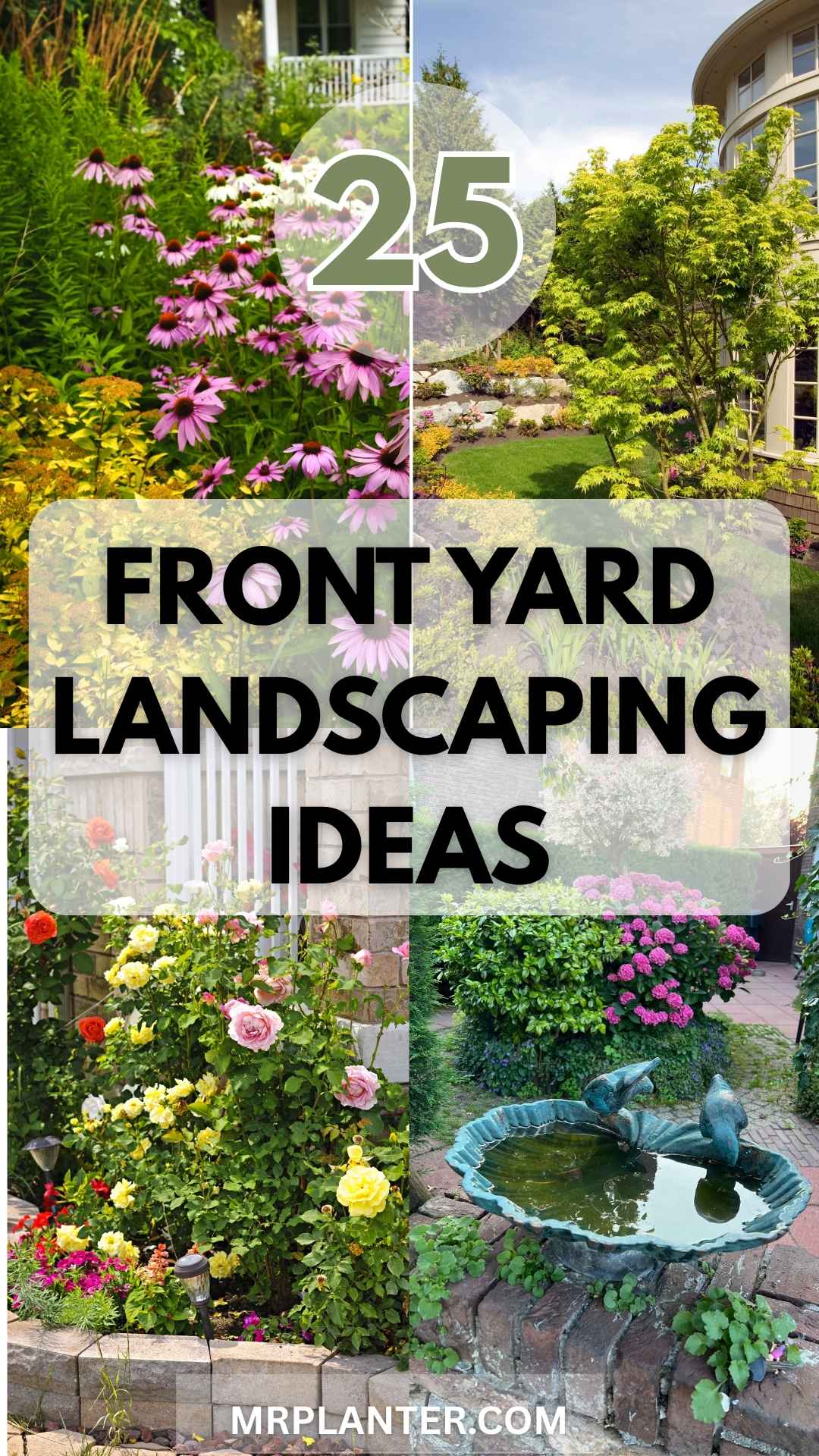
Understanding Your Front Yard’s Potential
So, before you begin with the ideas, let’s understand your front yard space by assessing it, understanding what’s already there, and considering your climate.
Assessing your space and existing features
Okay, so first thing – actually go outside and walk around your front yard. I know it sounds obvious, but most of us just rush past it every day without really looking.
Check out where it gets sunny versus shady, and see if there are any spots where water just sits after it rains. You might already have some decent stuff growing in your front yard that just needs a little love.
Also, think about where you actually walk to get to your car or front door, because you don’t want to plant something pretty just to stomp on it every day.
Considering your climate and maintenance capabilities
Here’s where people mess up all the time – they see some amazing yard on Instagram and try to recreate it without thinking about whether it’ll actually work where they live.
Like, if you’re somewhere super hot and dry, that gorgeous green garden probably isn’t gonna happen unless you want to spend your whole paycheck on water. And be real with yourself about maintenance too.
If you can barely remember to water houseplants, maybe skip the high-maintenance flowers and go with stuff that’s more chill.
Now, let’s get started with the ideas:
1. Add a colorful flower bed near the walkway
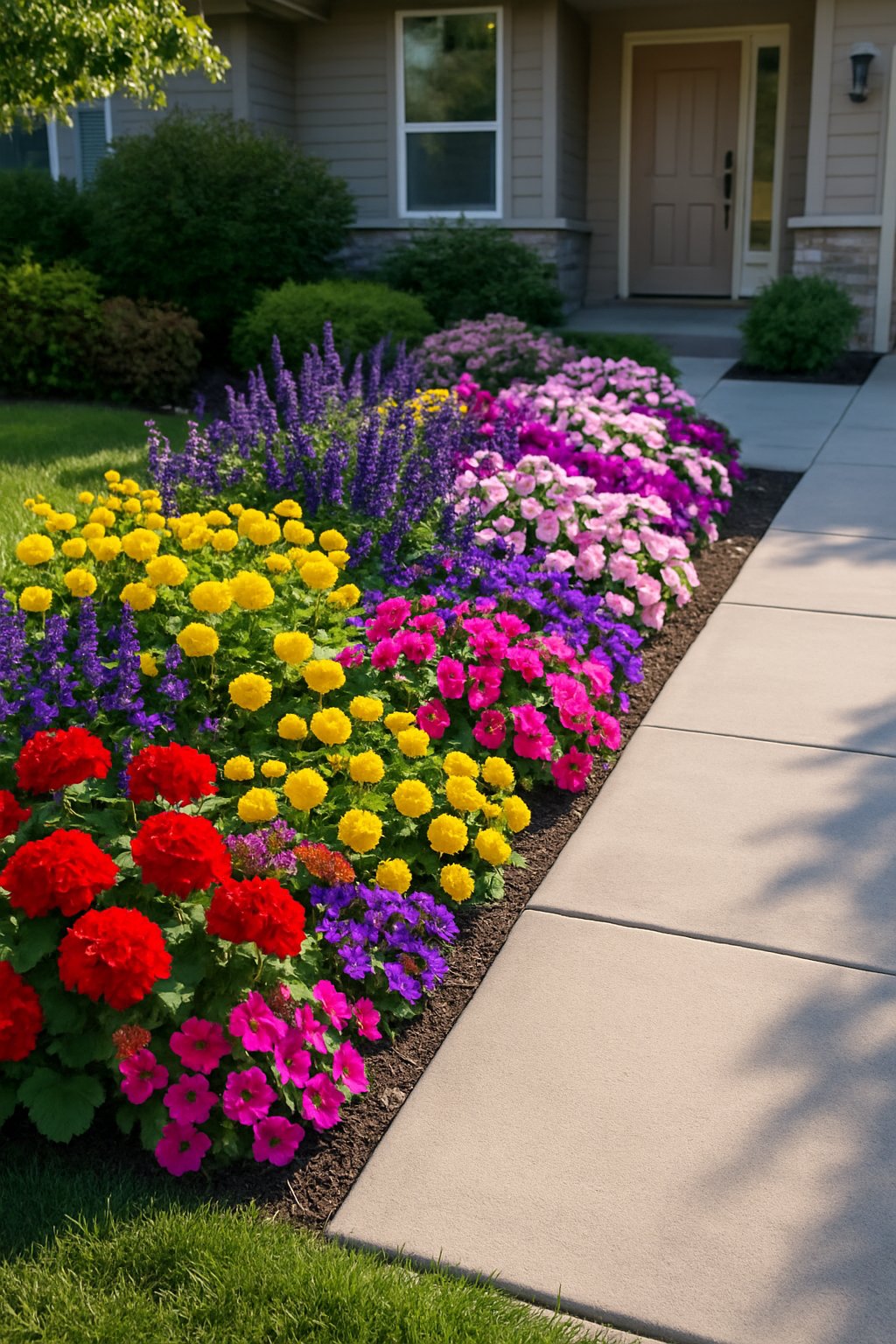
Try putting a flower bed right by your walkway. It instantly brightens the walk to your front door.
Mix up flower colors and heights so things look lively but not too packed.
Pick flowers that bloom at different times, and your bed will look good all year. Combine perennials and annuals for lasting color with hardly any fuss.
Toss in some low shrubs or little evergreens for structure. Even in winter, the bed stands out.
Bright flowers by the walkway grab attention and just make your home feel more welcoming.
Expert Tip from MrPlanter: “Go for plants that fit your climate. Put taller ones in the back and shorter ones near the path for the best effect.”
2. Plant blue grape hyacinths for spring color
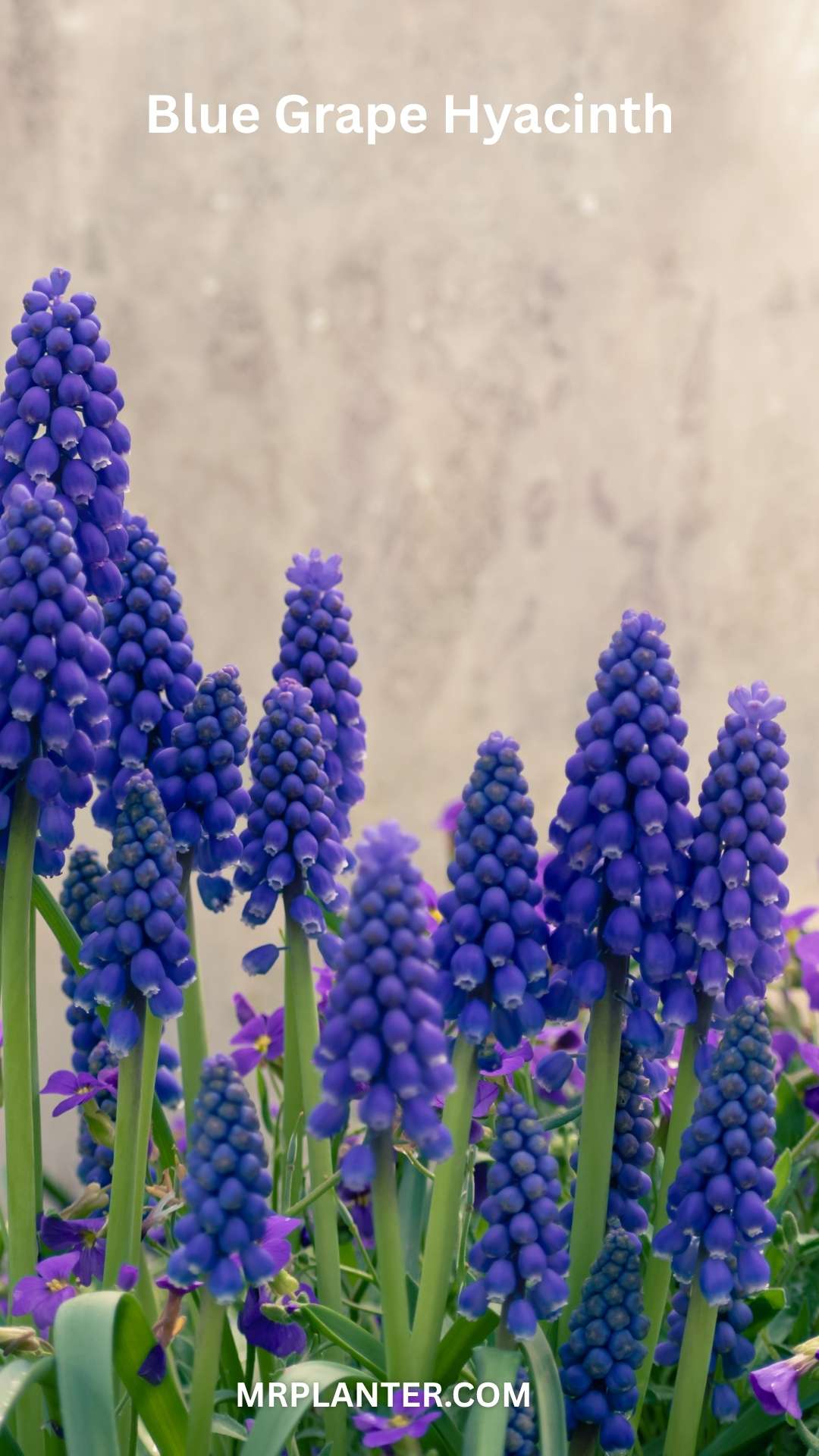
Blue grape hyacinths bring a punch of spring color to your yard. Their clusters of blue flowers look like tiny grapes—kind of quirky, but really pretty.
You can grow them easily in full sun or part shade. Just plant the bulbs in the fall, and you’ll get blooms in spring.
Space the bulbs about 4 to 6 inches apart. That way, you’ll get a nice, full patch that feels intentional.
They like well-draining soil, so skip soggy spots. This helps them bloom strong, year after year.
These flowers don’t get tall—usually just 6 to 8 inches. They’re great for edging or tucking in front of bigger plants.
Pair them with tulips or daffodils. The blue pops against yellows and pinks, which looks awesome.
Grape hyacinths barely need any care. After they bloom, let the leaves die back so the bulbs get ready for next year.
You can plant them along walkways or borders for a ribbon of blue that really stands out.
Expert Tip from MrPlanter: “Plant in groups for a bolder look. Water after planting, but don’t let them sit in water.”
3. Use yellow daffodils to brighten the lawn

Yellow daffodils add instant cheer to your yard every early spring. Their sunny color just makes everything feel fresh.
You can plant them in the sun or part shade, so they’re pretty flexible.
Daffodils take care of themselves and come back every year. Try planting bulbs in clusters or rows for bold color spots that really catch your eye.
They usually grow to about 14 inches, which makes them perfect for borders or along walkways.
Mix them with tulips or pansies if you want even more color.
Daffodils help cover up bare patches before your grass wakes up.
Plant bulbs in the fall for the best show in spring. They prefer soil that drains well, so avoid soggy spots.
Expert Tip from MrPlanter: “Groups of 5 or more bulbs look best. Keep them away from heavy foot traffic so the blooms stay nice.”
4. Incorporate evergreens for year-round greenery
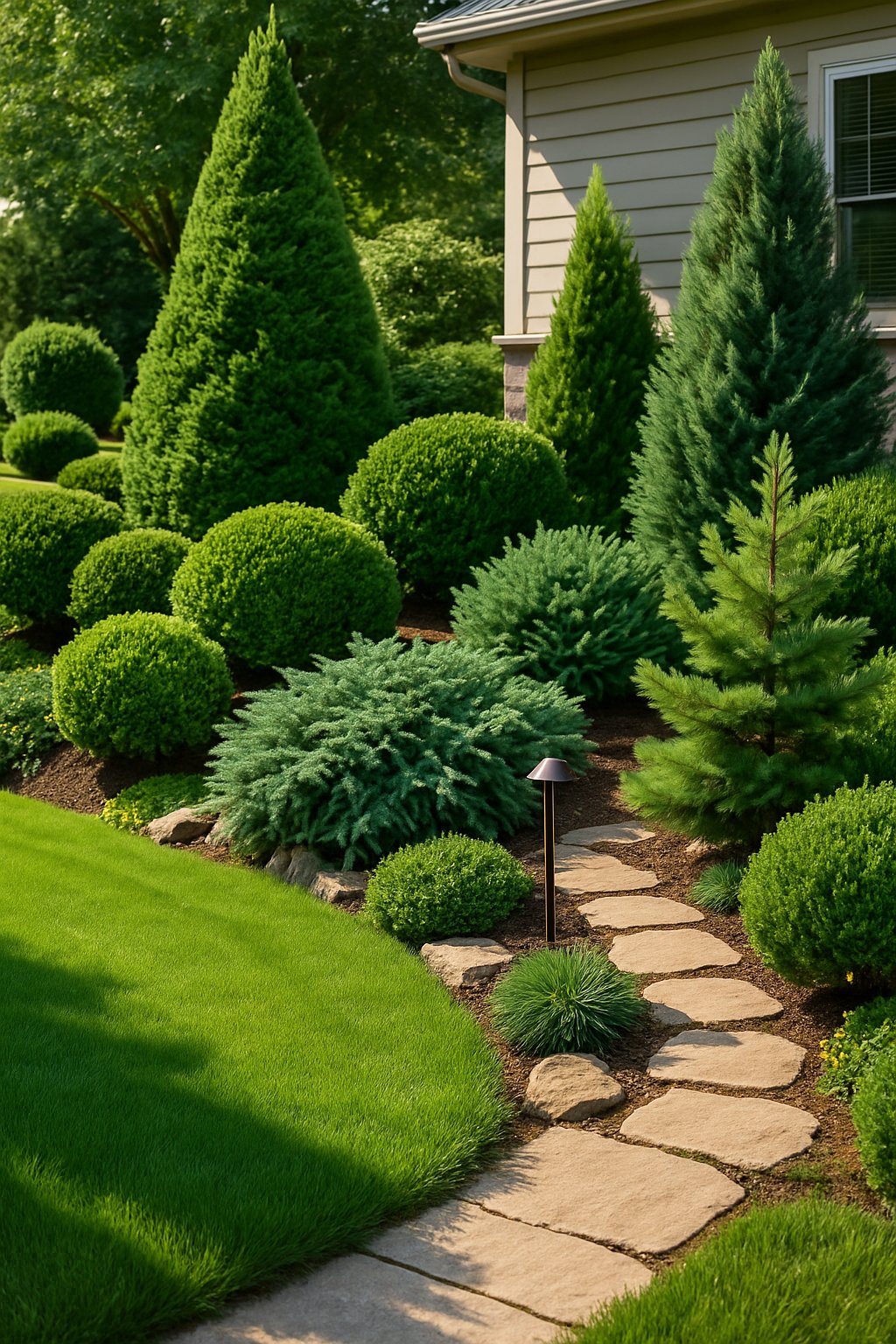
Evergreens keep your yard looking lively, even in the dead of winter. They give structure and color when everything else fades.
Try shrubs like boxwoods, holly, or juniper. Once they settle in, they need almost no work.
Mix up sizes and shapes for a textured look. You can use evergreens as privacy screens or just to edge your yard.
Put stones or mulch around them to really show off their green leaves.
Plant them where they’ll get enough sun—usually full or partial.
Expert Tip from MrPlanter: “Pick evergreens that handle your local weather. A little pruning each year keeps them tidy.”
5. Create a rock garden for low maintenance
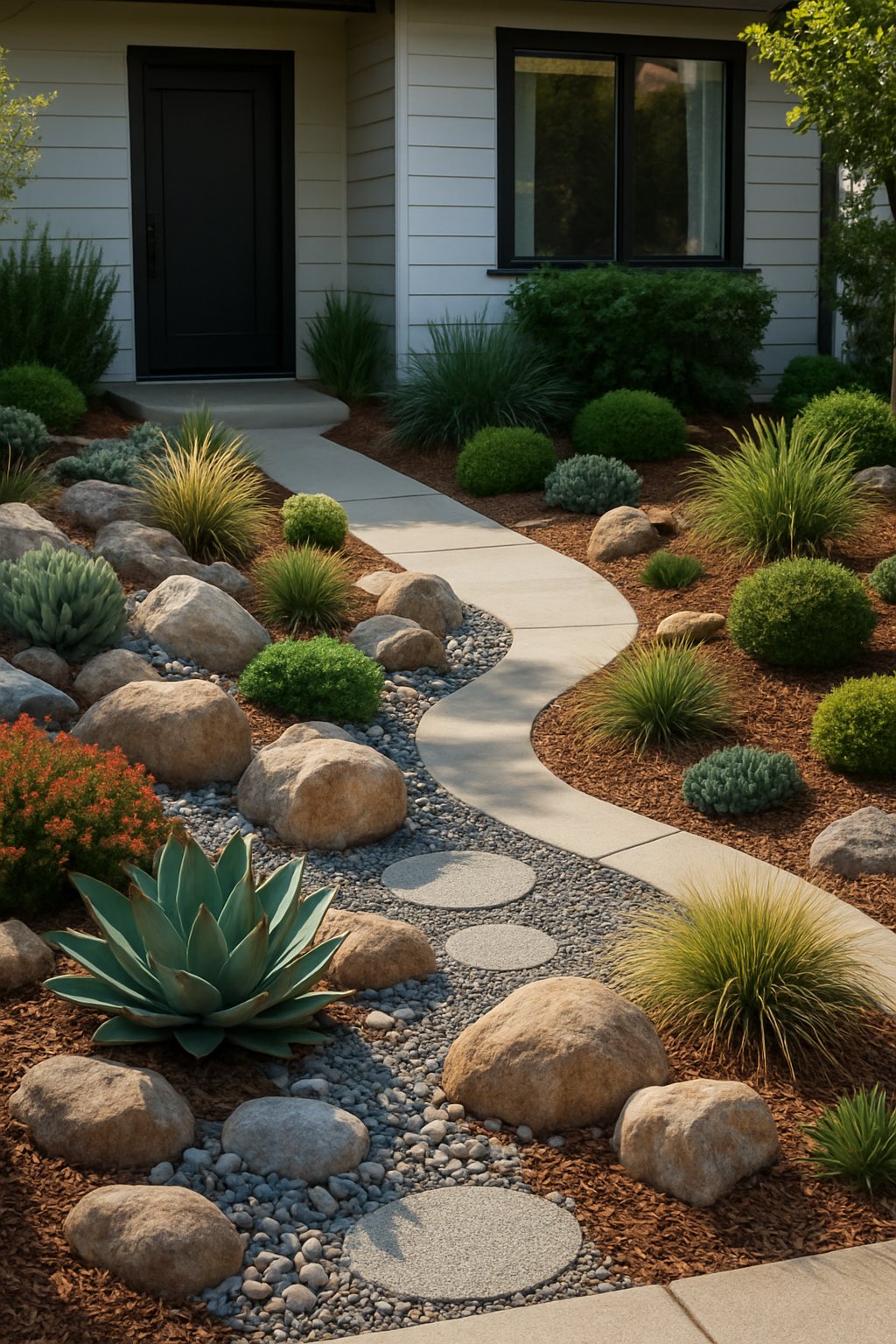
Rock gardens are perfect if you want less work and more style. Use different sizes and colors of rocks to make things interesting.
Rocks don’t need water or trimming, so you save time.
Add drought-tolerant plants like succulents or small shrubs around the rocks. This keeps things green but low effort.
Lay out flat stones for paths, and the whole space feels more welcoming.
Arrange rocks to guide guests through the yard. It gives everything a natural, tidy vibe.
This look works with lots of home styles, especially if you like things simple but sharp.
Expert Tip from MrPlanter: “Use rocks from your area so the garden fits in naturally. Keep plants with similar needs together to make care easier.”
6. Add a small water feature like a fountain
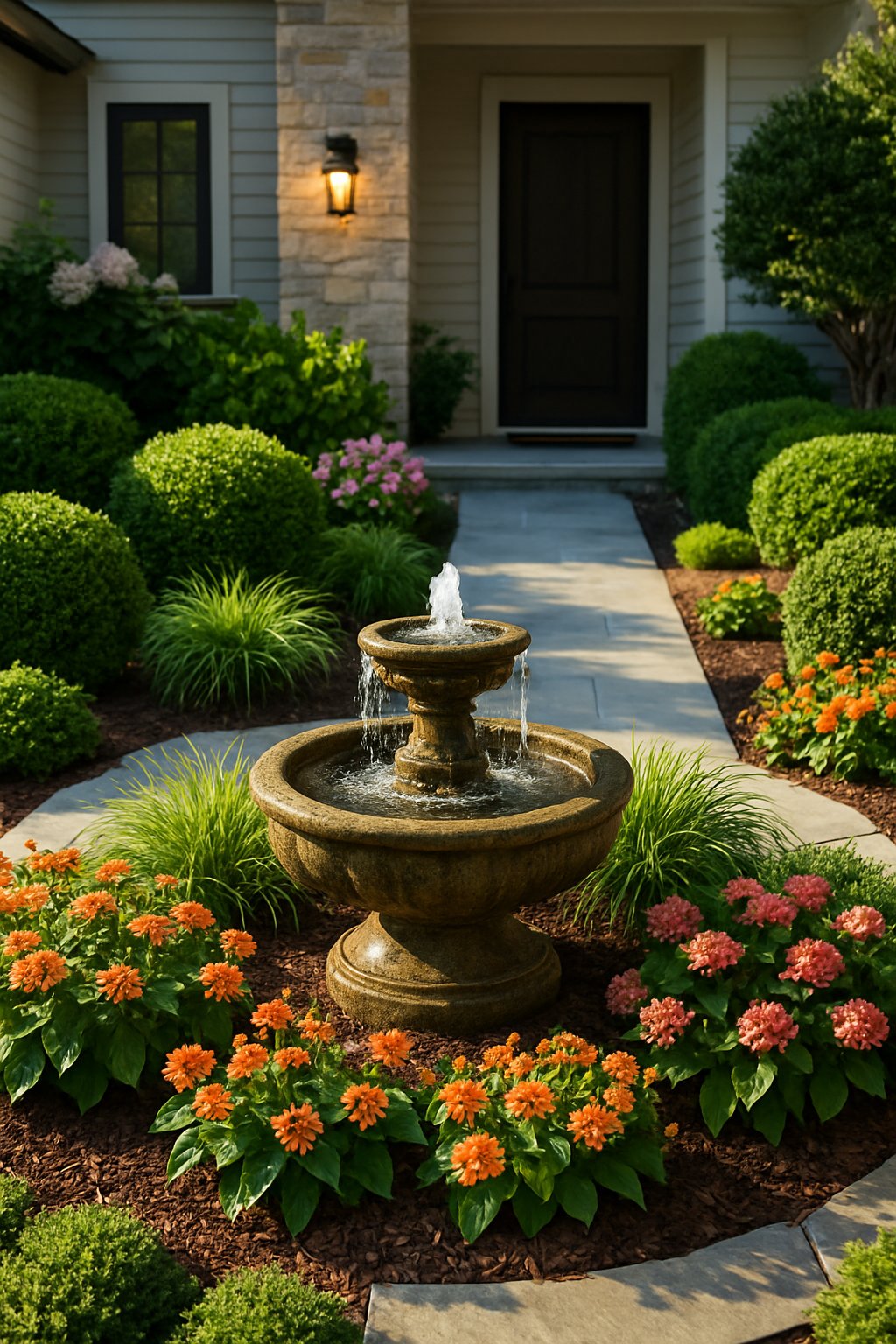
A small water fountain can bring a little peace and style to your front yard, even if you don’t have much room. Pick a stone or wooden design that matches your vibe.
Moving water adds a soothing sound—who doesn’t love that? Put your fountain near plants or rocks for a natural look.
If your yard’s tight, grab a compact fountain with a recirculating pump. It saves water and keeps things simple.
You can toss in floating plants like water lettuce for a splash of green. It’s a small touch, but it makes a difference.
Expert Tip from MrPlanter: “Set your fountain where you’ll see it from inside and outside. Use natural stones around the base so it blends right in.”
7. Use mulch to keep weeds down and soil moist
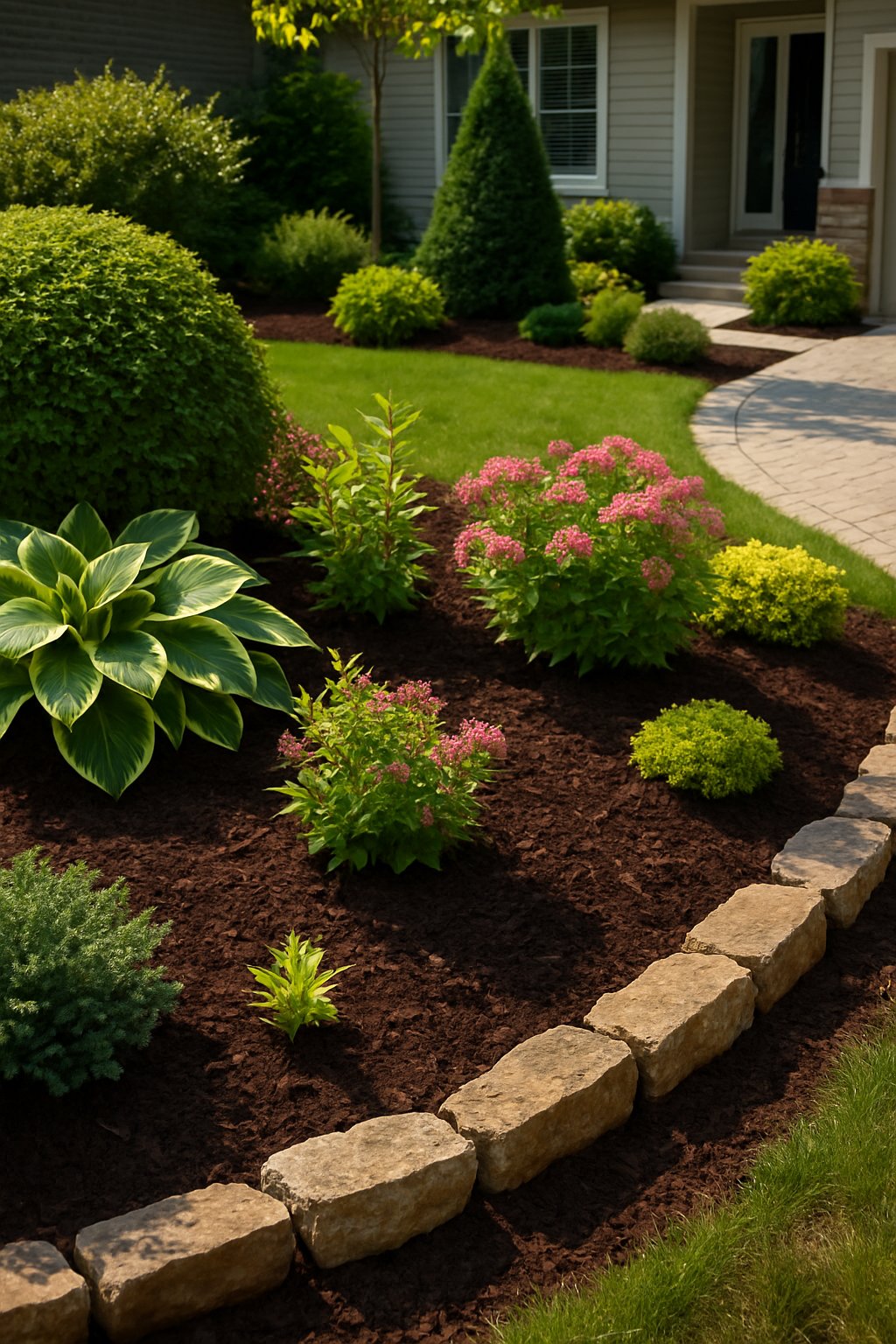
Mulch makes weed control way easier. A layer of mulch blocks sunlight, so weeds can’t pop up.
It also keeps moisture in the soil, so you won’t have to water as much. That’s a win in my book.
About 2 to 3 inches of mulch is enough. Too little won’t help, and too much can smother plants.
Go for organic mulches like wood chips or bark. As they break down, they actually improve your soil.
Pick a mulch that fits your climate and looks nice with your plants. Mulch keeps things tidy without much work.
Expert Tip from MrPlanter: “Mulch after watering to lock in moisture. Don’t pile it up against stems—plants hate that.”
8. Install solar garden lights along the path
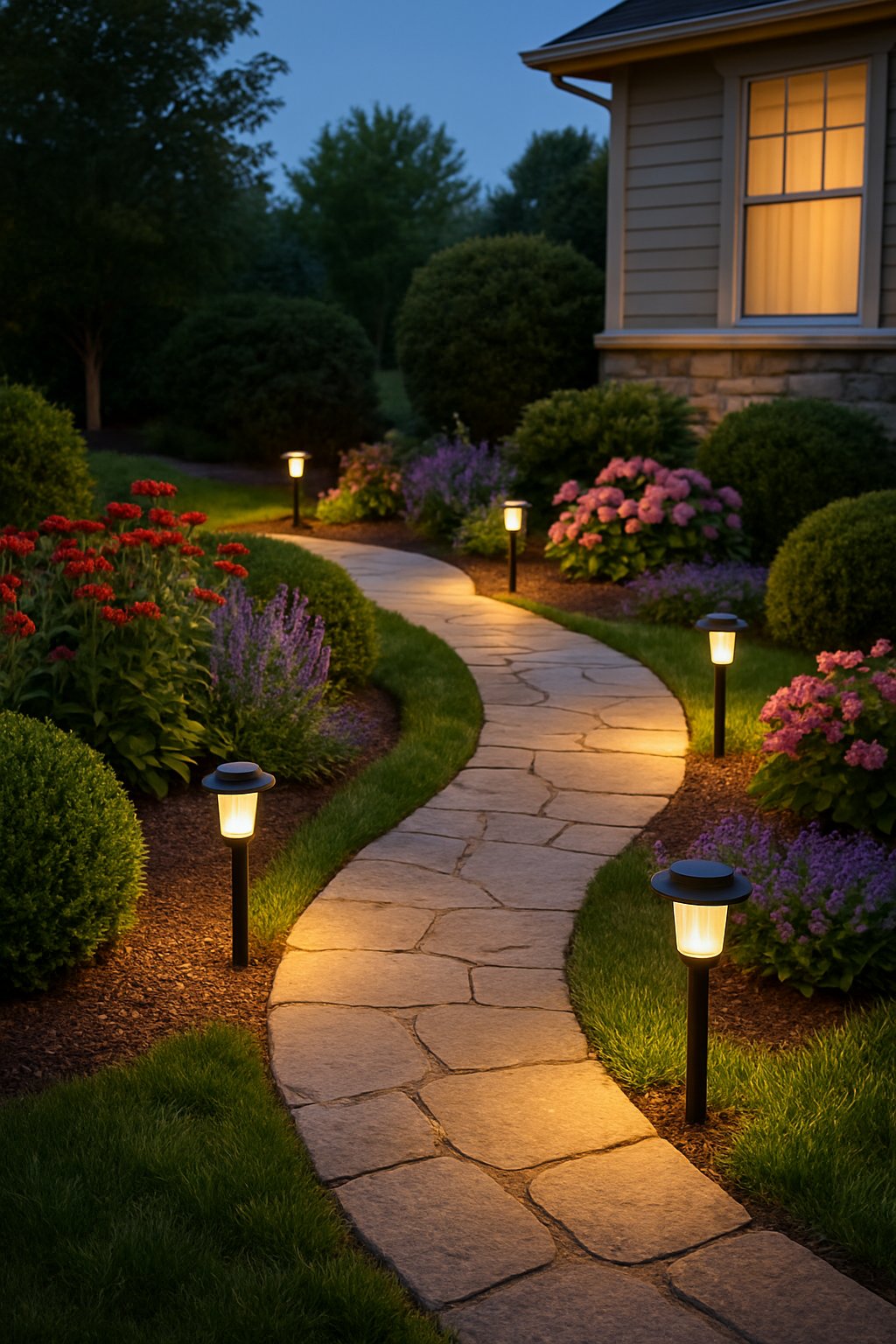
Solar garden lights along your path make it safer and way more inviting after dark. They soak up the sun all day, so you don’t need to mess with wires.
You can pick from little stakes or taller lights. Find a style that fits your yard.
Space them out to guide people and give off a cozy glow.
Highlight garden beds or hedges with these lights. It adds depth and makes your yard look great at night.
Solar lights are low maintenance, and you can move them if you want to change things up. Plus, they save energy.
Expert Tip from MrPlanter: “Put solar lights where they get direct sun for the brightest shine. Wipe the panels clean sometimes to keep them running strong.”
9. Line the driveway with fragrant shrubs

Fragrant shrubs along your driveway look good and smell even better. Try lavender, garden phlox, or lilac for a welcoming scent as you come and go.
These shrubs soften the driveway edges and add life to the space.
Pick types that thrive in your climate so you don’t have to fuss over them. Plant them close for a natural border that stays colorful all year.
Fragrant shrubs attract pollinators like bees and butterflies. You’ll get extra color and movement in your yard.
Water regularly, especially when it’s dry, to keep those scents strong.
Evergreens work too, if you want year-round coverage. Mix in seasonal flowers for a fresh look every few months.
Expert Tip from MrPlanter: “Go for shrubs with strong, pleasant scents. Give them enough space for air to flow—helps keep them healthy.”
10. Plant foundation shrubs around the porch
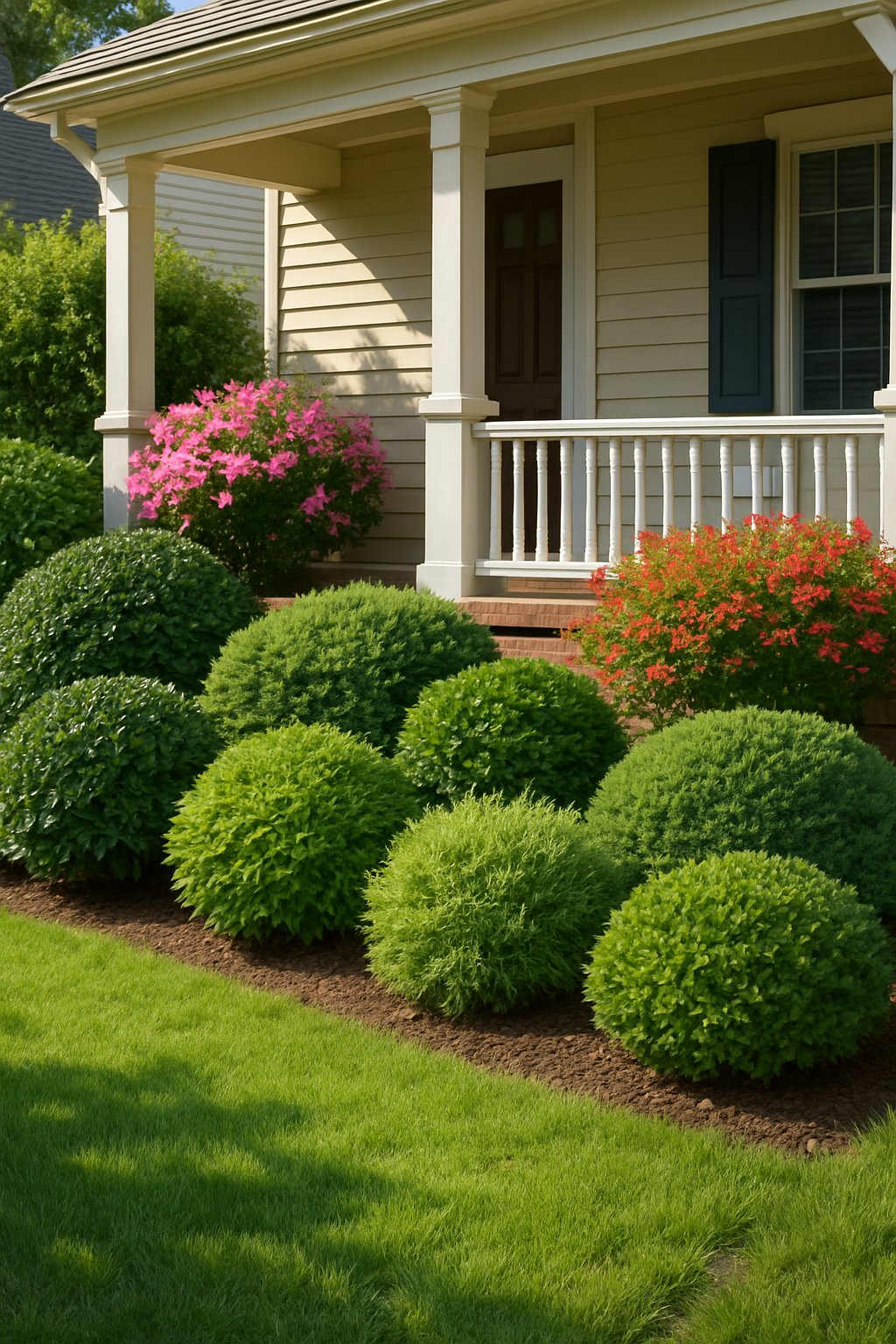
When you plant foundation shrubs around your porch, you give your home structure and a natural border. Pick low-growing evergreens like yew or boxwood so things stay tidy year-round.
These shrubs create a calm, green backdrop that really helps your porch pop. If you want a little more color, mix in shrubs with colorful leaves or flowers.
Burning bush or euonymus work great if you’re after something bright and easy. Just make sure you space them out so they don’t crowd your walkway or steps.
Trim your shrubs regularly to keep your porch open and welcoming. Watch the height too—shrubs under 4 feet won’t block windows or your views.
Give them proper watering and mulch, and they’ll stay healthy through every season. It’s honestly not that hard once you get the hang of it.
Expert Tip from MrPlanter: “Pick shrubs with different textures or colors to add depth around your porch. Always choose plants suited for your climate to keep maintenance low and results beautiful.”
11. Use ornamental grasses for texture
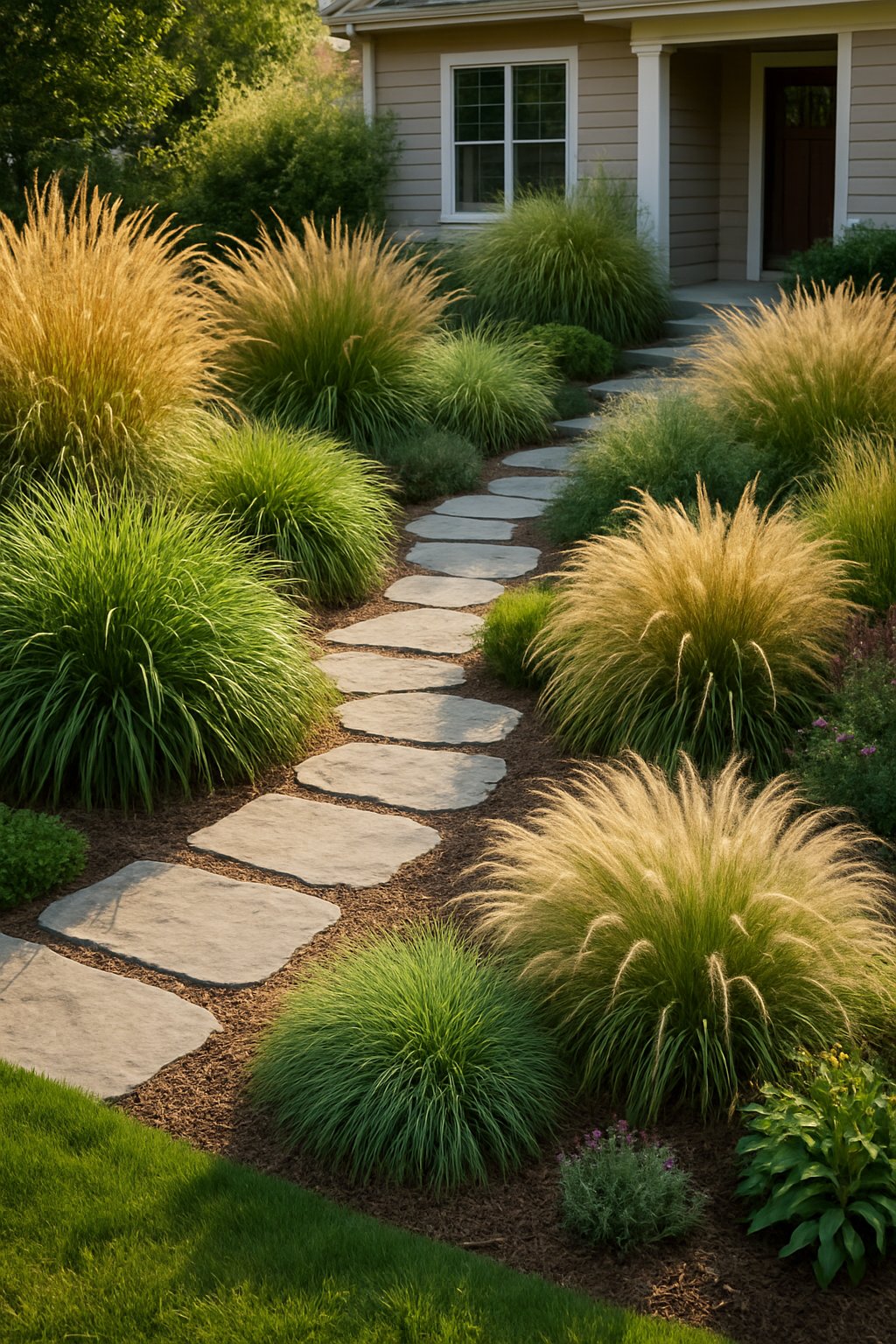
Ornamental grasses bring movement and texture to your front yard. They come in all sorts of heights, colors, and shapes, which makes your garden feel alive.
Try planting tall grasses for a bit of drama, or stick with shorter ones if you just want to fill in the gaps. Fountain grass, for example, has soft, feathery plumes that sway with every breeze.
A lot of ornamental grasses barely need any care, and they brighten up your yard year-round. Some even turn beautiful colors in the fall, which is always a nice surprise.
If you mix grasses with flowers and shrubs, you get a nice contrast. That balance makes your yard look more natural and less forced.
Expert Tip from MrPlanter: “Choose a mix of grass sizes to create layers of texture. Plant them in groups for the best visual impact.”
12. Build a raised garden bed with seasonal flowers
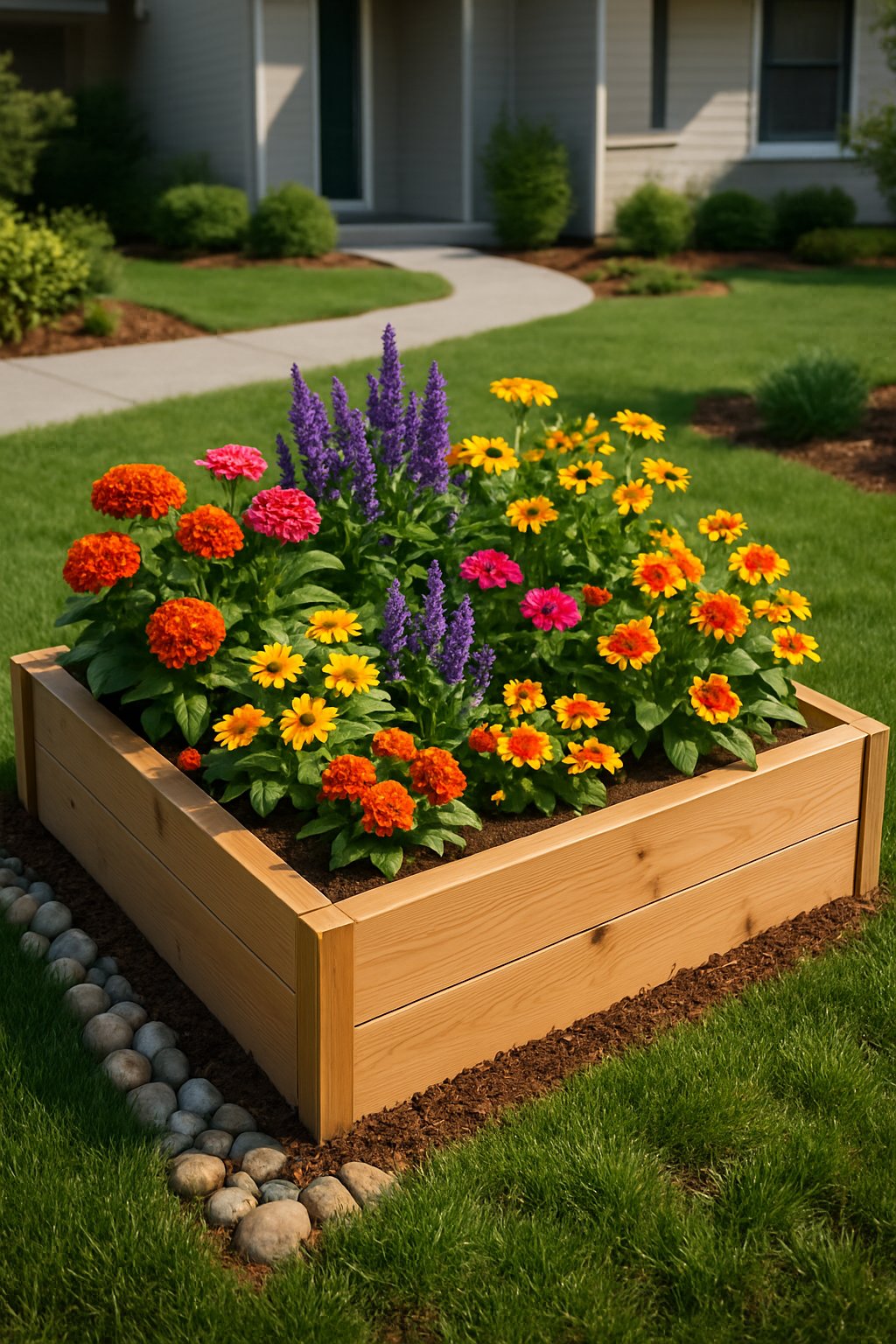
Build a raised garden bed if you want an easy way to add color to your front yard. Swap out the flowers each season to keep things fresh.
Pick a sunny spot and choose a size that fits your space. Fill your bed with good soil so your flowers have the best chance.
In spring, plant bulbs like tulips or daffodils for a burst of color. When summer hits, swap in marigolds or zinnias that love the heat.
For fall, mums will keep your bed looking lively even as the weather cools. Raised beds also keep the soil warmer and drain better, so your flowers thrive.
Expert Tip from MrPlanter: “Choose different flower heights for a layered look. Change plants every 2-3 months for constant color.”
13. Add a birdbath as a focal point
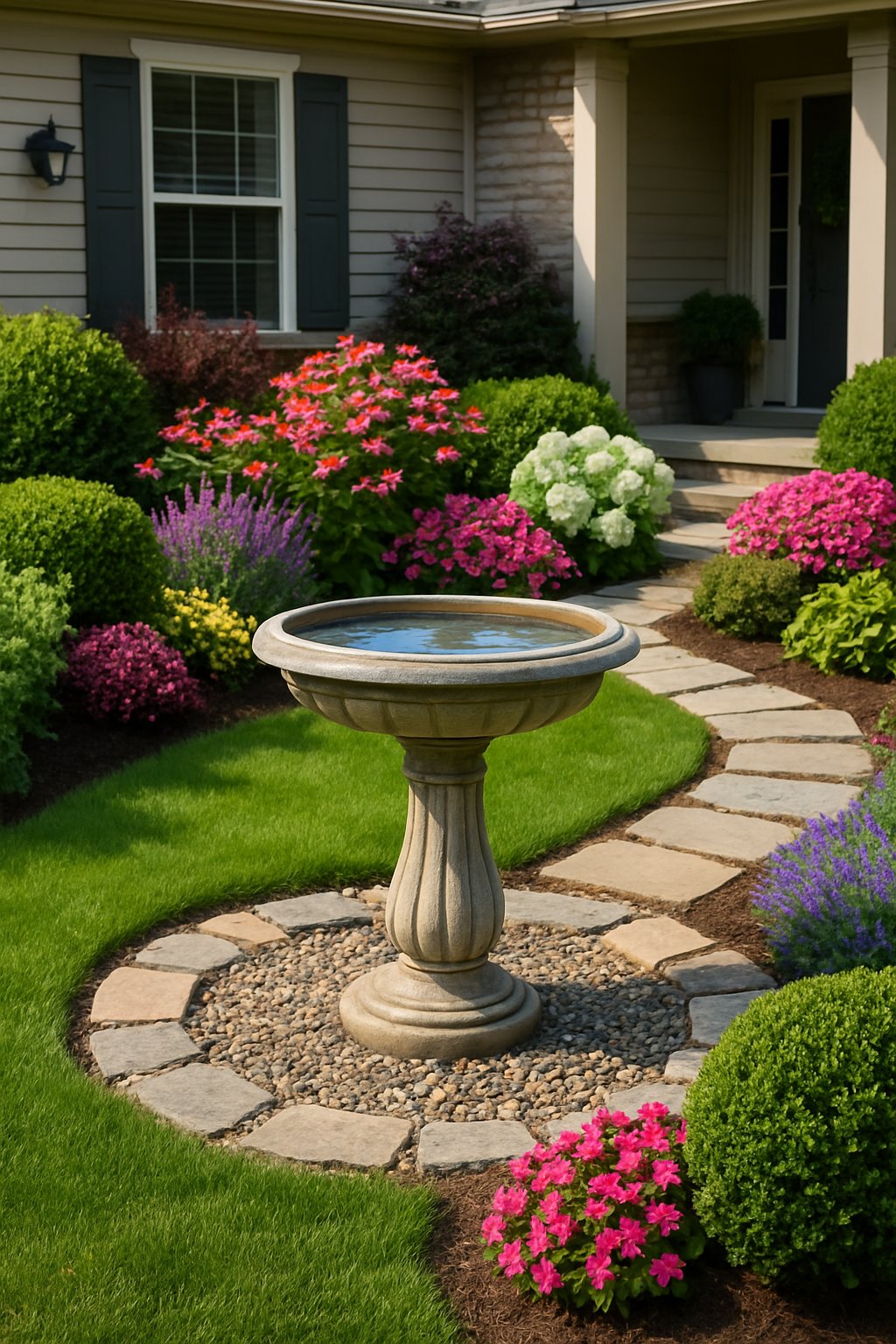
A birdbath instantly brings beauty and life to your front yard. It attracts birds, making your garden feel more alive and connected to nature.
Pick a style that matches your vibe, whether it’s classic stone or colorful pottery. Put the birdbath where you can see it from your window or porch—trust me, you’ll want to watch the birds.
Surround it with plants or flowers for a natural look that birds love. If you add a small fountain, the moving water stays cleaner and draws in even more birds.
Look for materials that fit your garden’s style. Pottery with bright patterns suits a southwestern yard, while copper or glass adds color without being too loud.
A good birdbath can easily become the centerpiece of your landscape. It’s a small change that makes a big difference.
Expert Tip from MrPlanter: “Place your birdbath near shrubs to give birds shelter. Clean it regularly to keep birds healthy and visiting often.”
14. Create a cottage-style garden with mixed flowers
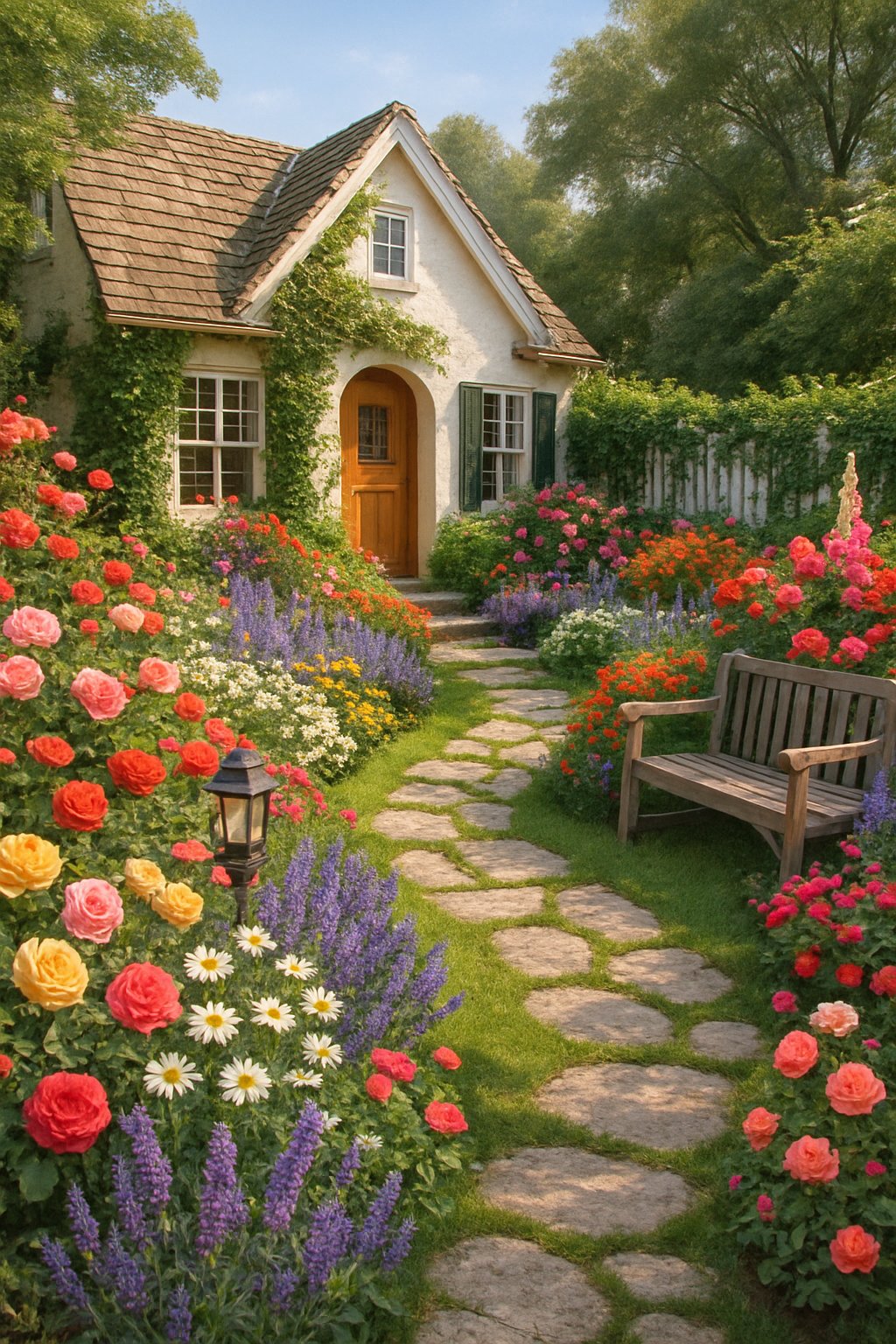
If you want a relaxed, colorful front yard, go for a cottage-style garden. Mix flowers like daisies, foxgloves, and lavender for that wild, natural look.
Forget strict patterns—just let your plants grow freely for a casual, welcoming vibe. Toss in some herbs or small veggies for extra variety and scent.
Old pots or simple containers add charm and character, and curving paths lead visitors through your flower beds. The space feels cozy and a bit magical.
Add a picket fence or a few small statues if you want a classic cottage feel. Those little touches give your yard a storybook look without much effort.
Expert Tip from MrPlanter: “Choose plants that bloom at different times for year-round color. Group flowers in clusters for a fuller look with less maintenance.”
15. Include succulents for drought resistance
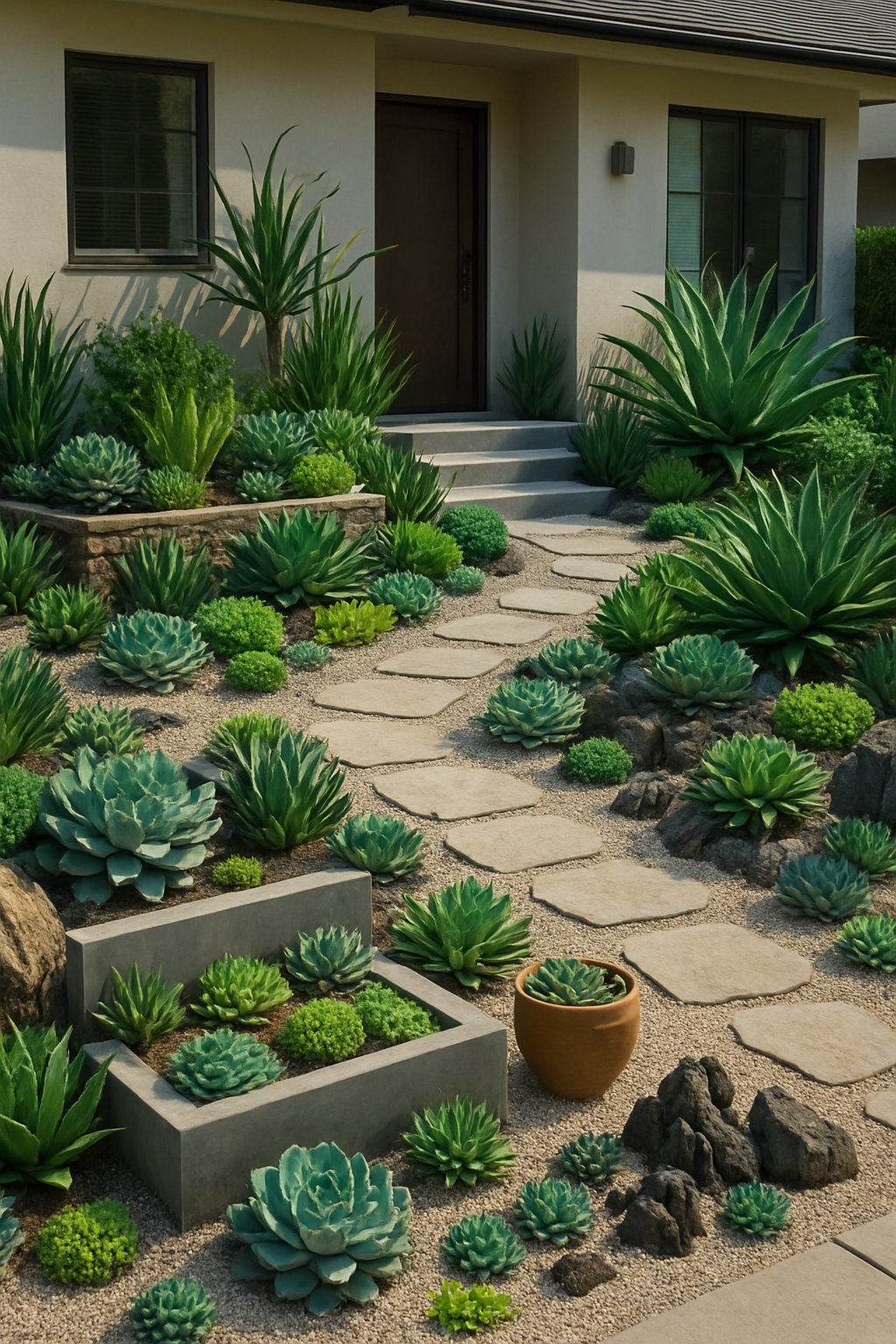
Succulents work wonders in front yards because they barely need any water. Plant them in groups to create cool shapes and textures.
You’ll find them in all sorts of colors and sizes, so you can really make your yard stand out. Try mixing succulents with rocks or gravel for a low-maintenance, stylish look.
These plants only need water about once every one or two weeks, so you save time and water. Line your pathways or fences with low-growing succulents for easy green borders.
Succulents handle heat like champs, making them perfect for dry areas. Add a few big rocks to balance out the colors and shapes—it just looks good.
Expert Tip from MrPlanter: “Use gravel or sand around your succulents to improve drainage and prevent rot. Arrange plants with varied heights for a more dynamic display.”
16. Use stepping stones for a whimsical path
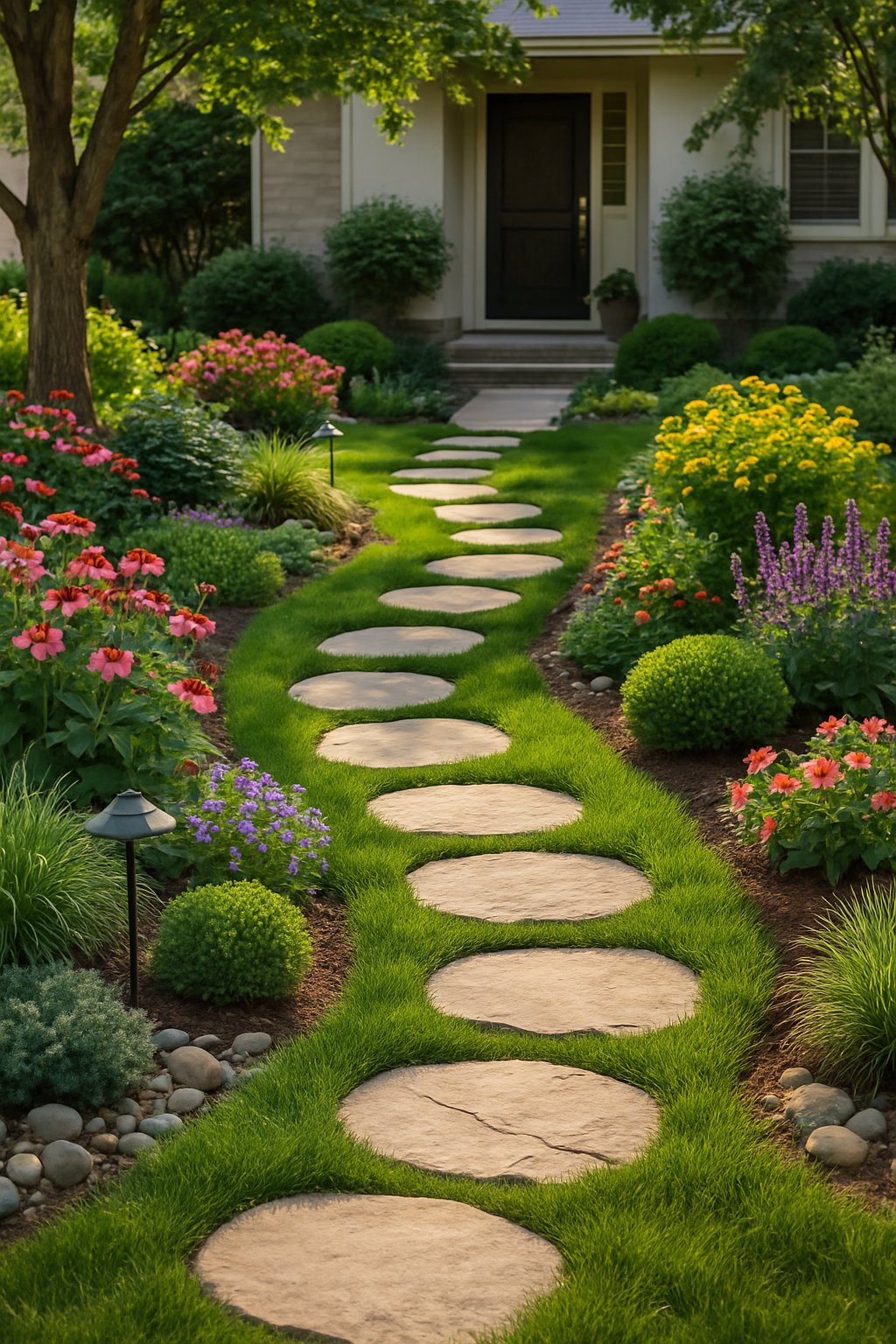
Stepping stones bring charm and a bit of fun to your front yard. Pick stones in different shapes, colors, or patterns to make a playful walkway.
Mix up materials—concrete, natural stone, or even painted rocks all work. Space the stones out so grass or ground cover can grow between them for a softer, more natural look.
Plant a few small flowers or ground covers along the edges to make your path feel magical. If you’re feeling bold, try glow-in-the-dark stones for nighttime walks.
That way, you get beauty and a little extra safety. Leaf shapes, footprints, or mosaics can tell a story in your garden if you want to get creative.
Expert Tip from MrPlanter: “Place stepping stones on a firm base to keep them stable. Use mulch or ground cover between stones to reduce weeds and add color.”
17. Add a small bench for seating

Pop a small bench in your front yard to boost both the look and function of your space. It’s a cozy spot to sit and enjoy the outdoors, whether you’re alone or with a friend.
Try placing it under a tree, near some flowers, or by the porch for the best view. Pick a bench that matches your yard’s size and style.
Wooden benches feel natural, while metal or stone ones look more modern. If space is tight, go for a narrow or foldable bench.
A bench makes your yard look more welcoming and lived-in, even if you don’t use it every day. It signals that your home is friendly and inviting.
Customize your bench with cushions or a splash of paint to match your garden colors. Add a planter beside or above it to blend seating with your plants.
Expert Tip from MrPlanter: “Place your bench where you get some shade during hot days. Use weather-resistant cushions to keep it comfy and durable.”
18. Plant lavender for fragrance and color
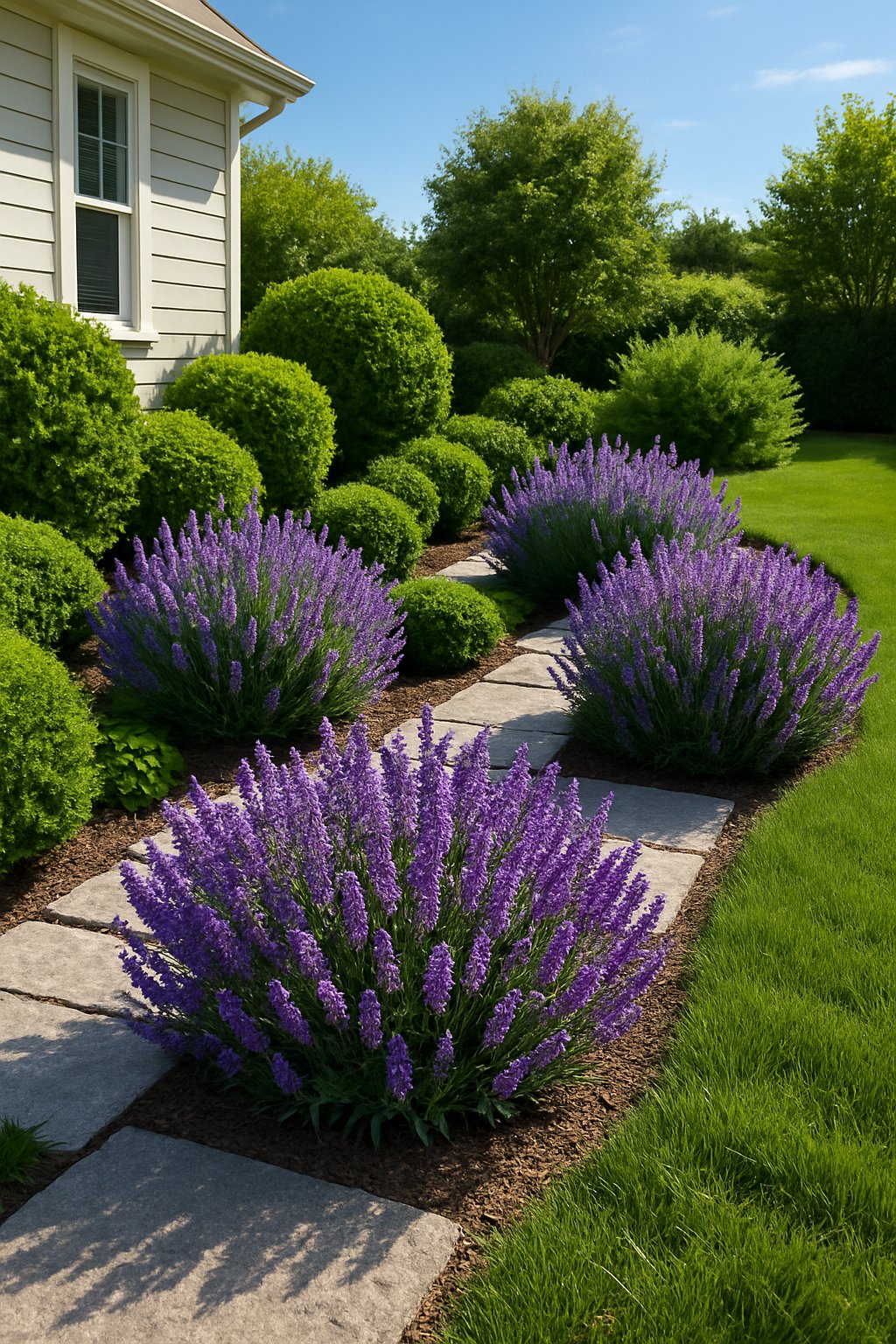
Plant lavender in your front yard if you want both a lovely scent and soft purple color. Lavender grows best in sunny, well-drained spots, and it’s honestly pretty easy to care for.
Line your pathways or fill flower beds with lavender for color and texture. Even when it’s not blooming, those silver-gray leaves look nice.
Lavender pairs well with rosemary and thyme, giving your yard a Mediterranean vibe. It’s also great around seating areas so you can enjoy the fragrance up close.
Try planting it in groups or as a low hedge to frame your space. With a little pruning, lavender stays tidy and resists pests, so you don’t have to fuss over it.
Expert Tip from MrPlanter: “Choose a sunny spot with good drainage for healthy lavender. Prune after flowering to keep the plants compact and full.”
19. Incorporate native plants for easy care
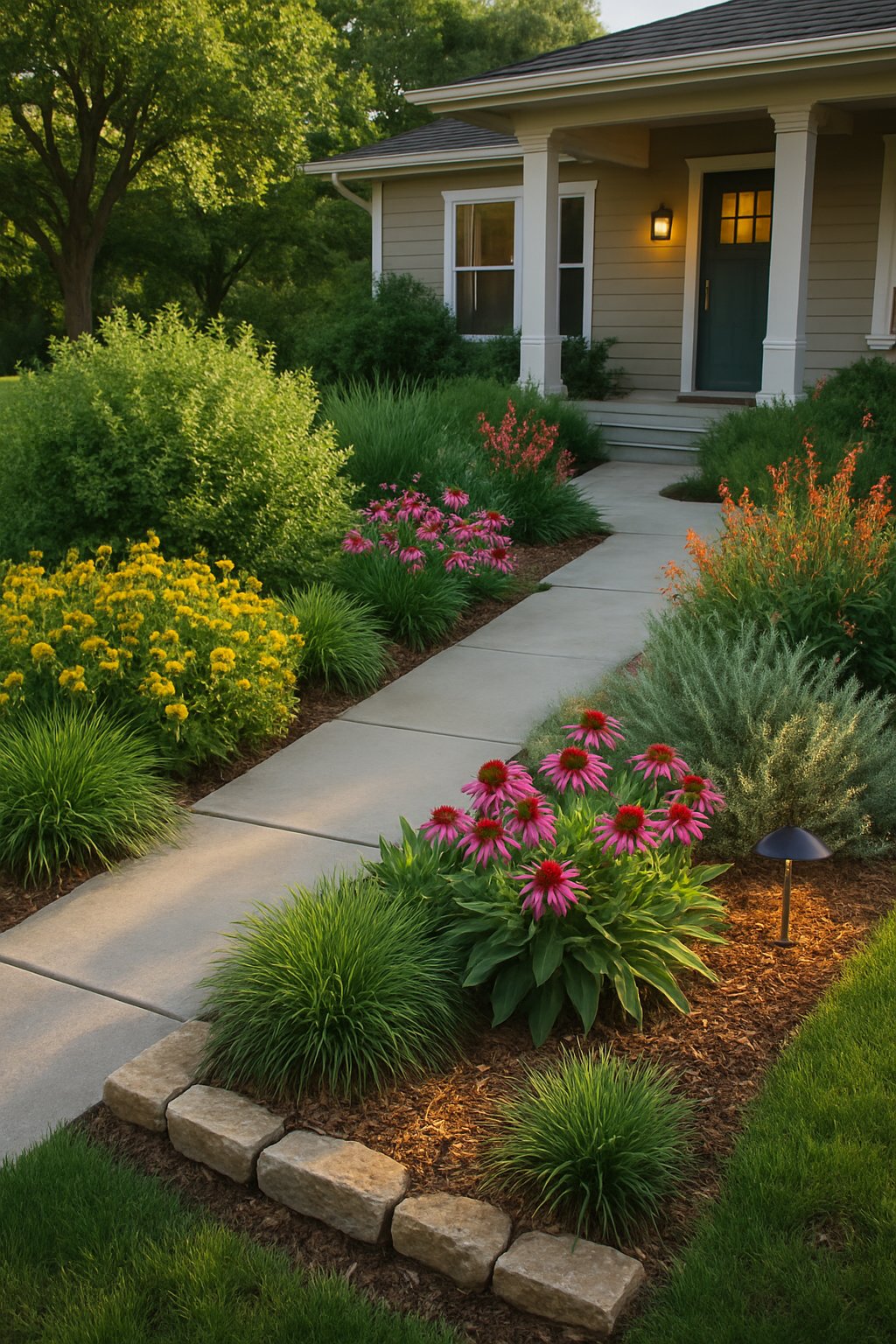
If you want to save time and effort, plant native plants in your front yard. These plants have already adapted to your local climate and soil, so they barely need extra water or chemicals.
Native plants attract helpful wildlife like bees and butterflies, which keeps your garden healthy in a natural way. They also add unique beauty that just fits the area around your home.
When you pick native plants, you cut down on work—less mowing, less watering. That means you get to enjoy your outdoor space more and stress less.
Expert Tip from MrPlanter: “Pick a variety of native plants that bloom at different times to keep your yard colorful year-round. Group plants with similar water needs together to make watering easier.”
20. Use boxwood hedges for a classic look
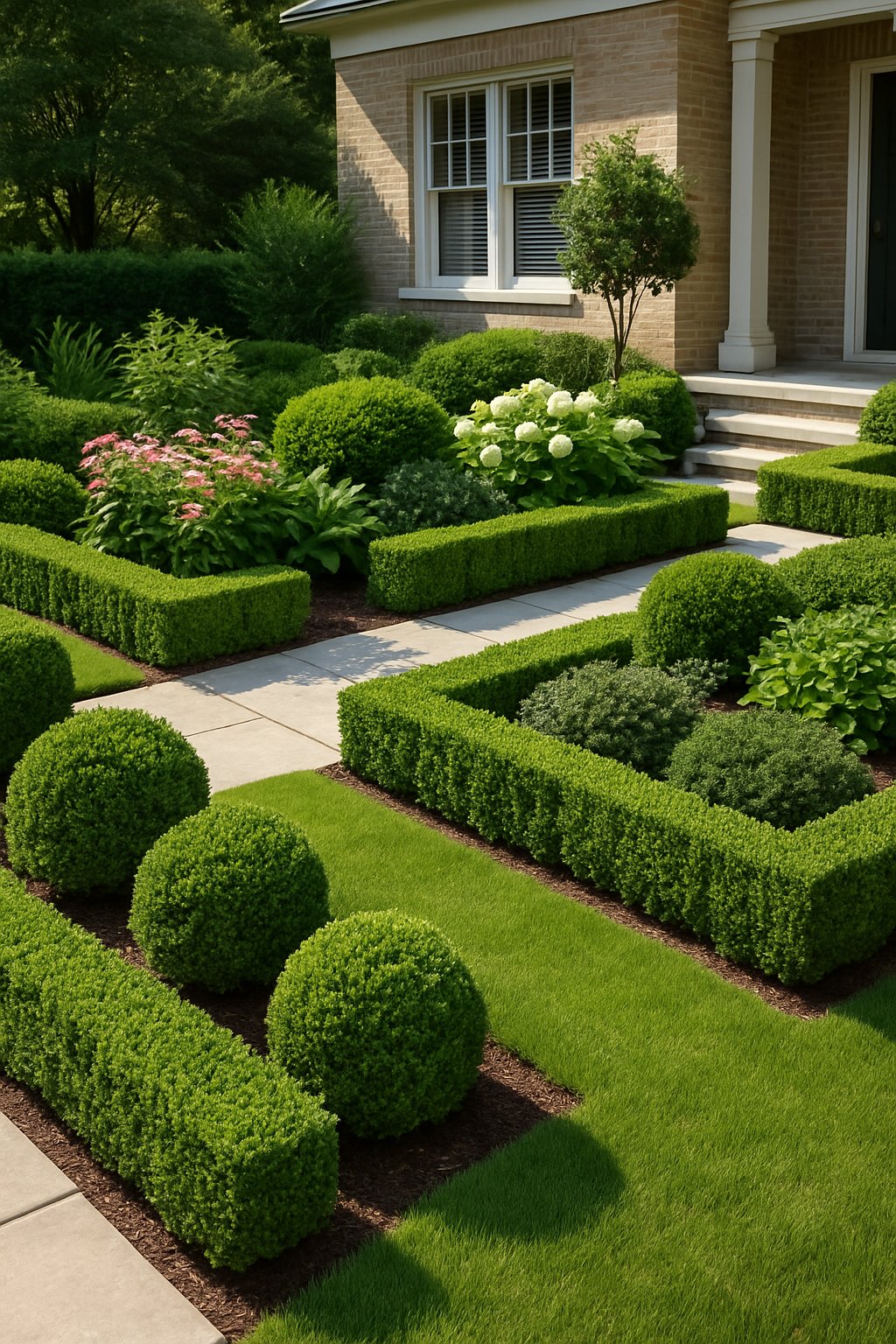
Boxwood hedges give your front yard that clean, timeless style everyone loves. They work especially well as borders along walkways or around flower beds.
Trim them into neat shapes if you want to add some structure and order to your yard. It’s kind of satisfying to keep them looking sharp.
These shrubs stay green all year, so your landscape always looks fresh, no matter the season. Boxwoods don’t really need much care—just regular watering and the occasional trim to keep their shape.
You can also use them to frame entrances or even create small garden walls. Their dense leaves block unwanted views and add privacy, but they don’t block out the light.
Expert Tip from MrPlanter: “Trim your boxwoods in early spring to encourage full, healthy growth. Use sharp shears for clean cuts that heal quickly.”
21. Add colorful annuals each season
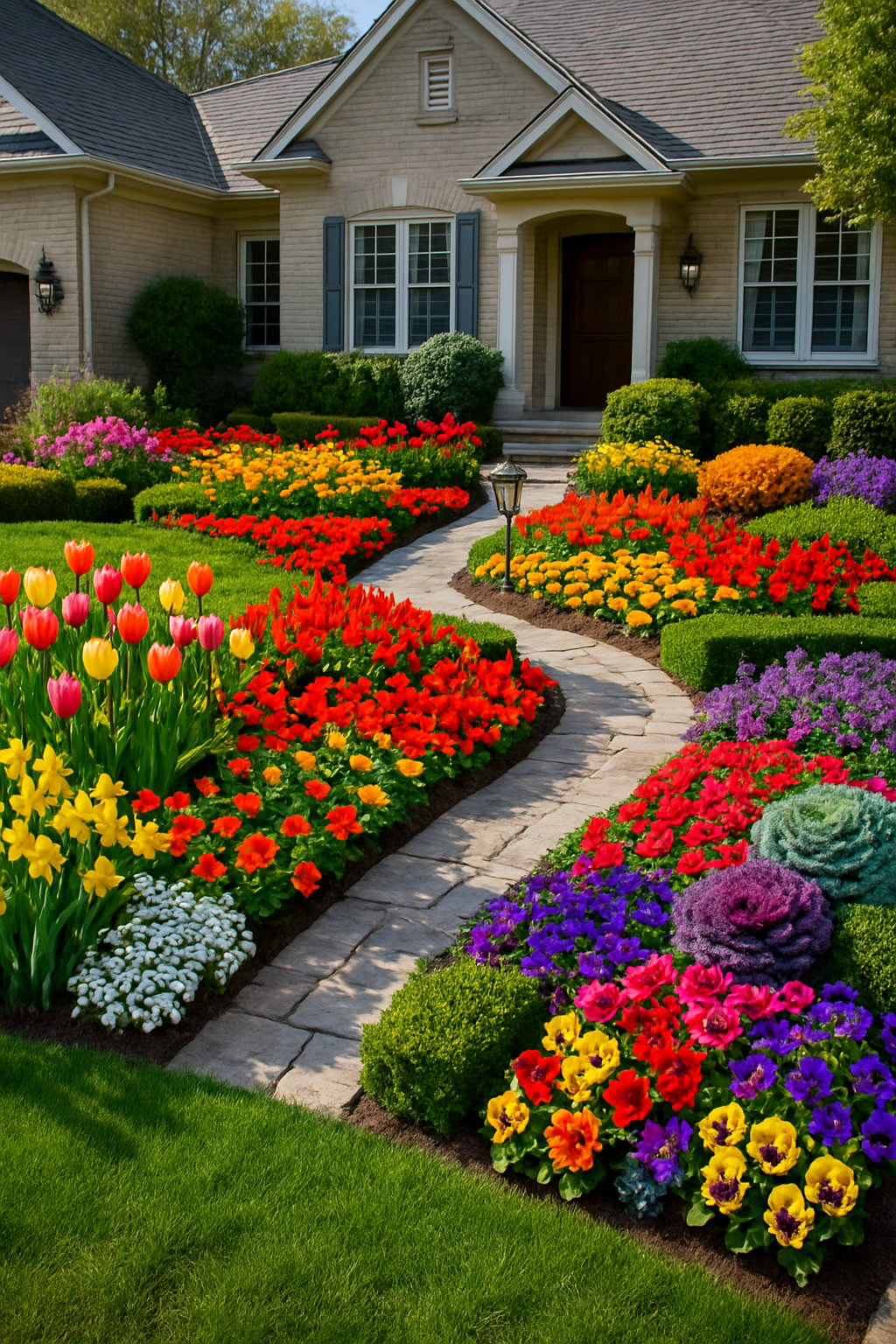
Adding annual flowers to your front yard is a quick way to keep things looking fresh and bright. Annuals bloom fast and fill empty spots with a burst of color.
Switch up the flower colors with the seasons. For spring and fall, plant cool-season annuals like pansies or snapdragons.
When summer hits, go for zinnias or marigolds—they handle the heat like champs. Annuals work well with perennials too, filling in gaps between blooms and stretching your garden’s color.
Pick flowers that suit your light and soil conditions for the best results. Plant annuals where they get enough sun and good drainage.
Water them regularly, but don’t overdo it. If you deadhead spent blooms, you’ll keep the flowers coming.
Expert Tip from MrPlanter: “Mix different shapes and colors of annuals to create a lively look. Rotate your choices each year to keep your garden interesting and healthy.”
22. Plant a small ornamental tree like a dogwood
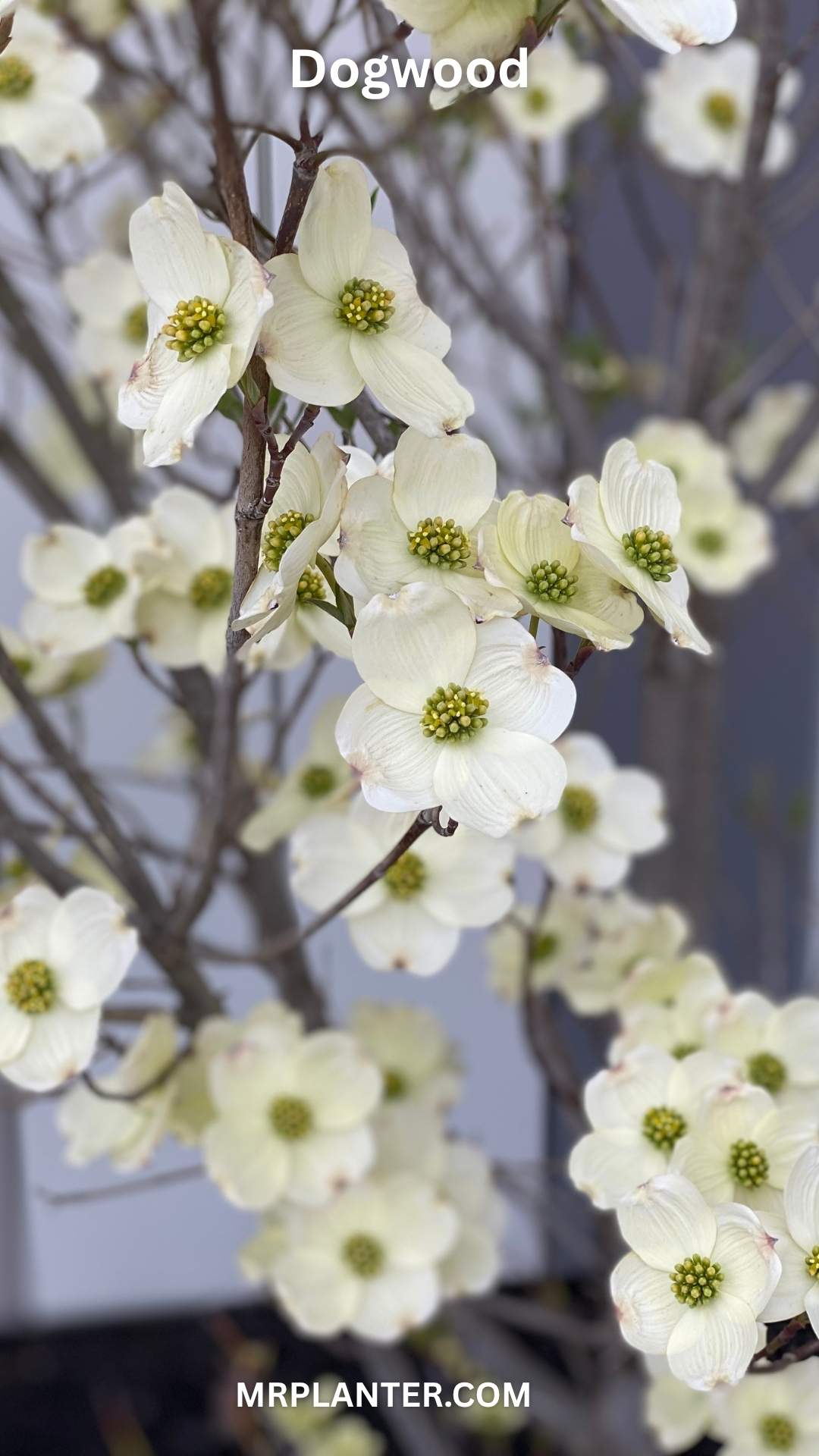
A dogwood tree makes a great choice for your front yard. It stays on the smaller side but still offers those beautiful spring flowers everyone notices.
You also get red fruits in late summer and colorful leaves in fall. Dogwoods grow well in full sun or part shade, so they’re pretty flexible.
They like soil that drains well but stays moist. Try planting one as a focal point near your walkway or porch.
Surround your dogwood with low plants like ferns or tulips for a tidy look. This combo adds color and texture all year.
Dogwoods tend to resist most diseases, so you won’t have to worry much about extra care. Choose a variety that fits your space, maybe the flowering dogwood—it adds charm without crowding your yard or roots.
Expert Tip from MrPlanter: “Make sure to water your dogwood regularly during dry spells. Mulching around the base helps keep roots cool and moist.”
23. Use ground covers to reduce the grass area
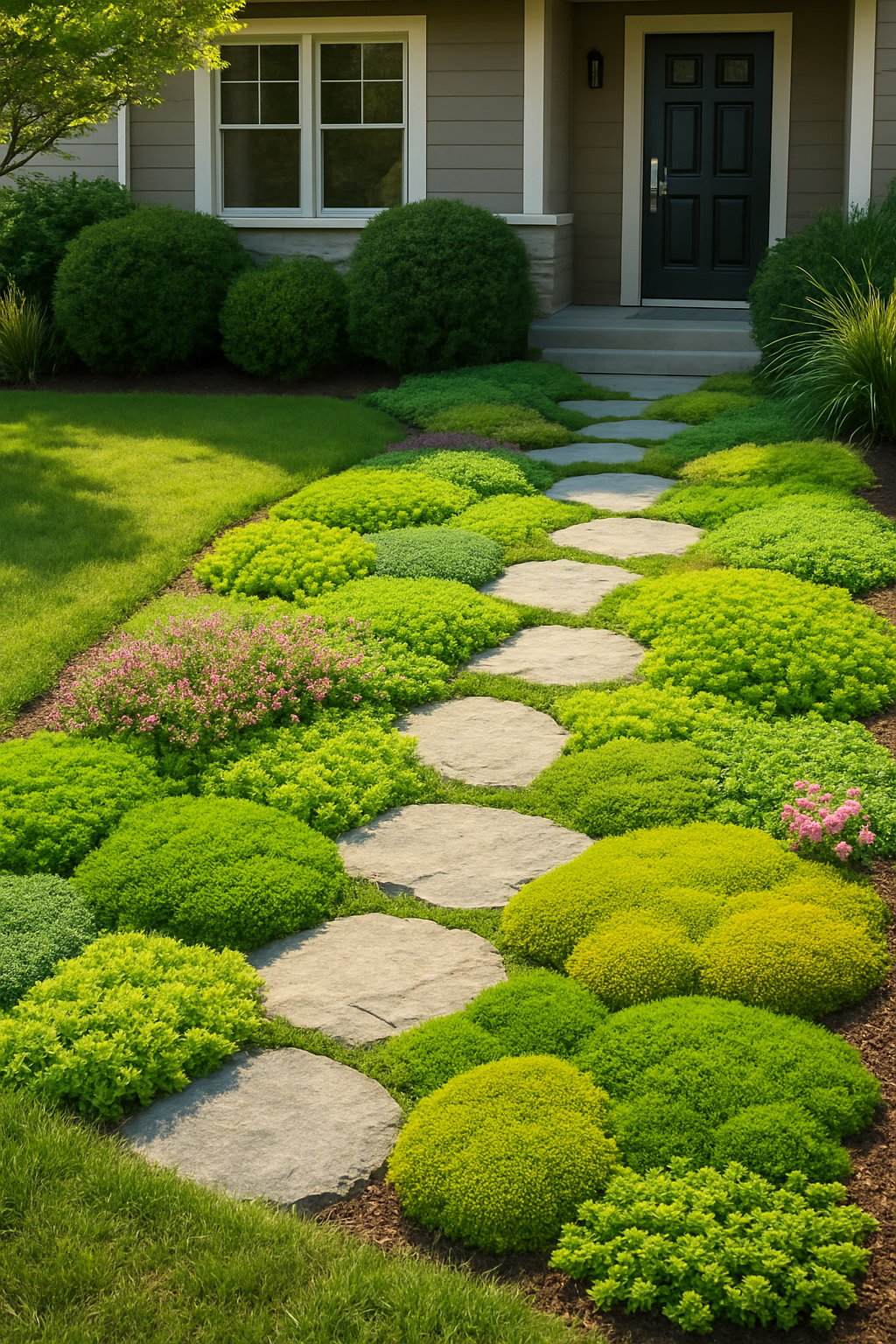
Ground covers are a smart way to cut down on grass in your front yard. They grow low and spread quickly, filling in empty spaces with barely any effort.
You can pick from lots of types, like creeping thyme, clover, or Snow-in-Summer. These plants usually need less water than grass, and you won’t have to mow them.
Ground covers also help prevent weeds, so your yard stays neat longer. They add texture and color to your space without much extra work.
Choose varieties that match your yard’s sun and water levels for the best results. Mixing ground covers with shrubs or flowers makes the landscape a lot more interesting.
Expert Tip from MrPlanter: “Start with a small area of ground cover to see how it spreads before expanding. Always check the plant’s sun and water needs to keep it healthy and low maintenance.”
24. Install a wrought iron garden gate
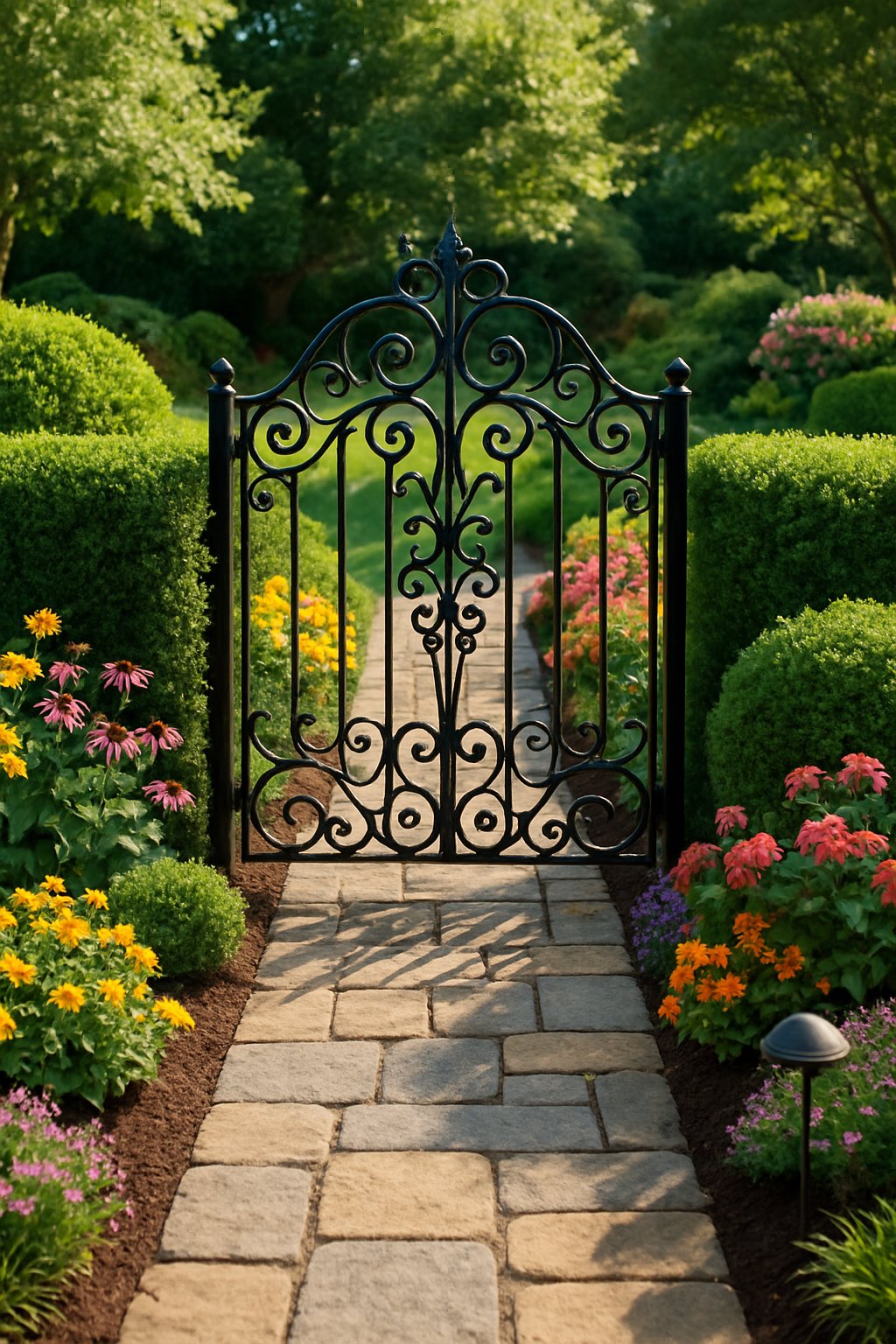
A wrought iron garden gate brings charm and style right to your front yard. It marks a clear entrance that welcomes visitors and really defines your space.
You’ll find these gates in all sorts of designs, so you can pick one that fits your home’s vibe. Wrought iron gates give you security without blocking the view.
They’re strong but still lightweight and easy to install. You won’t need much maintenance either, which is always a plus.
Adding a wrought iron gate can even bump up your property’s value. It gives your yard that timeless, elegant feel that just lasts.
Expert Tip from MrPlanter: “Choose a gate design that matches your fence for a balanced look. Regularly clean and paint your gate to keep it looking new and prevent rust.”
25. Add climbing vines on trellises

If you add climbing vines on trellises, you’ll instantly bring some height and a bit of drama to your front yard.
Trellises help your plants grow upward, which saves space and creates a natural screen or even a bold focal point.
Go for sturdy materials—wood or metal usually does the trick—so your trellis can handle whatever weather comes along.
Vines like clematis, wisteria, or climbing roses bring color and that sweet fragrance everyone loves.
Try putting trellises near your porch, along a winding path, or right up against your fence.
This trick helps define spaces and somehow makes everything feel a little more welcoming.
If you grow edible vines like peas or beans, vertical supports make picking them so much easier.
Check your vines often and tie any new shoots gently to the trellis.
That way, you’ll avoid breakage and help the plant climb without much fuss.
Expert Tip from MrPlanter: “Pick a trellis design that matches your yard’s style for a neat look. Start with young plants and train them early to cover the structure evenly.”

